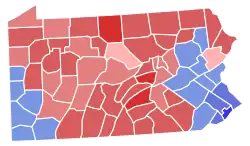Politics of Pennsylvania
Pennsylvania has swung from being a Republican-leaning state during much of the 20th century to being a notable battleground state in presidential elections. Pennsylvania backed the Democratic presidential candidate in every election since 1992 up until 2016, when it was won by Republican candidate Donald Trump. Pennsylvania currently has a split government, with the governor's office being held by a Democrat Tom Wolf and both houses of the state legislature being controlled by the Republican Party. In the United States Senate, Pennsylvania is represented by Democrat Bob Casey Jr. and Republican Pat Toomey. In the United States House of Representatives, Pennsylvania is represented by nine Democrats and nine Republicans.

In 2008, Democrat Barack Obama won the state by a margin of over 10 percent, the largest victory seen in a presidential election in Pennsylvania since Richard Nixon's victory in 1972. In 2016, Donald Trump became the first Republican presidential candidate to win Pennsylvania since George H.W. Bush in 1988, winning by a margin of 0.7 percent. In 2020, Democrat Joe Biden defeated Donald Trump in the state by 1.2 percent.
History
| Year | Democratic | Republican |
|---|---|---|
| 1952 | 46.9% 2,146,269 | 52.7% 2,415,789 |
| 1956 | 43.3% 1,981,769 | 56.5% 2,585,252 |
| 1960 | 51.1% 2,556,282 | 48.7% 2,439,956 |
| 1964 | 64.9% 3,130,954 | 34.7% 1,673,657 |
| 1968 | 47.6% 2,259,405 | 44.0% 2,090,017 |
| 1972 | 39.1% 1,796,951 | 59.1% 2,714,521 |
| 1976 | 50.4% 2,328,677 | 47.7% 2,205,604 |
| 1980 | 42.5% 1,937,540 | 49.6% 2,261,872 |
| 1984 | 46.0% 2,228,131 | 53.3% 2,584,323 |
| 1988 | 48.4% 2,194,944 | 50.7% 2,300,087 |
| 1992 | 45.2% 2,239,164 | 36.1% 1,791,841 |
| 1996 | 49.2% 2,215,819 | 40.0% 1,801,169 |
| 2000 | 50.6% 2,485,967 | 46.4% 2,281,127 |
| 2004 | 50.9% 2,938,095 | 48.4% 2,793,847 |
| 2008 | 54.5% 3,276,363 | 44.2% 2,655,885 |
| 2012 | 52.0% 2,990,274 | 46.6% 2,680,434 |
| 2016 | 47.5% 2,926,441 | 48.2% 2,970,733 |
| 2020 | 50.0% 3,458,229 | 48.8% 3,377,647 |
Philadelphia is the Democratic stronghold of the state, often delivering huge margins for the Democrats in statewide elections. Other urban areas, such as Pittsburgh, Erie, Harrisburg, Allentown, and Scranton lean Democratic as well. Like most states, Pennsylvania's rural areas tend to be more conservative and support Republicans. The resulting political map of Pennsylvania is therefore a red "T" in the center of the state with the Pittsburgh and Philadelphia areas a strong blue. In more recent years, the traditionally Democratic-voting areas in southwestern Pennsylvania have become much more Republican, especially after 2004, similar to other coal country areas in West Virginia and Kentucky. By 2016, counties that once voted for John Kerry in 2004 in the counties surrounding Allegheny County supported Donald Trump by more than 60%. The true swing areas of the state are the suburbs of the large cities, notably Philadelphia, which change year-to-year.
Pennsylvania’s former Senator, Arlen Specter, announced in April 2009 that he was switching his party affiliation from Republican to Democratic, citing the Republicans' shift to the right since he was elected in 1980, though others suspected he switched because he would face a tough Republican primary election in 2010.[2] As it turned out, he ended up losing the Democratic primary to Representative Joe Sestak. Congressman Sestak narrowly lost the general election to Pat Toomey in November 2010, returning the Senate seat to Republicans.
On the state level, Pennsylvania has been a traditionally liberal Republican state, with a dominant state Republican Party that is much more oriented towards social spending than more conservative state Republican Parties in other regions of the United States. However, the recent Democratic trend in Pennsylvania has affected state politics, and the Democrats controlled the governor's mansion for two terms under Governor Ed Rendell. After losing the governorship for four years to Tom Corbett from 2011 to 2015, Democratic Governor Tom Wolf defeated Corbett's re-election bid in 2014.
On January 22, 2018, the Supreme Court of Pennsylvania mandated that the state's congressional map be redrawn, alleging that the current map was unconstitutionally drawn to favor Republicans and disenfranchise Democratic voters, a process known as gerrymandering. Less than one month later, a new congressional map was drawn and approved. The new map would take place in the May primaries.[3] With the new congressional map in place, Democrats had a net gain of three congressional seats, giving the Democratic Party half of Pennsylvania's congressional seats. Also in the 2018 midterm elections, Governor Tom Wolf won reelection by a margin of 17 percent, Bob Casey Jr. was reelected to a third term in the U.S. Senate, John Fetterman unseated incumbent lieutenant governor Mike Stack, and the Republican Party maintained control of the state legislature.[4][5][6]
Federal relations
During the Tom Ridge administration, the Commonwealth of Pennsylvania maintained a permanent in-house lobbying office in Washington, D.C., to lobby the federal government of the United States.[7] During the Ed Rendell administration, the Commonwealth closed that office and entered into a $720,000 annual contract with Blank Rome to lobby the federal government.[7] The Rendell administration says that the contract with Blank Rome was $140,000 less per year than maintaining a permanent state office in Washington.[7]
See also
References
- Leip, David. "General Election Results – Pennsylvania". Dave Leip's Atlas of U.S. Presidential Elections. Retrieved November 18, 2016.
- Cillizza, Chris. "The Fix - Specter To Switch Parties". Voices.washingtonpost.com. Retrieved 2010-11-27.
- Cohn, Nate (February 19, 2018). "The New Pennsylvania Congressional Map, District by District". The New York Times. Retrieved January 12, 2020.
- Couloumbis, Angela (May 15, 2018). "Braddock Mayor John Fetterman wins Pa. Democratic primary for lieutenant governor". The Philadelphia Inquirer. Retrieved January 12, 2020.
- Brennan, Chris (November 7, 2018). "Pa. House and Senate remain in Republican control despite Democratic gains". The Philadelphia Inquirer. Retrieved January 12, 2020.
- Thompson, Charles (November 7, 2018). "Five takeaways from the 2018 mid-term elections, Pa. Legislature division". PennLive. Retrieved January 12, 2020.
- Bumsted, Brad; Mike Wereschagin (November 29, 2009). "Lobbyist expenses wasteful, critics say". Pittsburgh Tribune-Review. Archived from the original on November 30, 2009.
3.^ "Correbett Could be the First Governor to lose Re-election in PA History" [Michael LaRosa, http://www.msnbc.com/hardball/corbett-could-be-first-governor-lose-re-el]
4.^ "Pennsylvania Governor Tom Corrbett loses Election" , Reid Wilson
